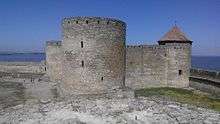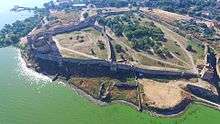Bilhorod-Dnistrovskyi fortress

Bilhorod-Dnistrovskyi fortress (or Akkerman fortress) is a historical and architectural monument of XIII-XIV centuries. It is located in Bilhorod-Dnistrovskyi in Odessa region (southwestern Ukraine).

History
Start of construction
The fortress was based on the remains of the Tyras, ancient Greek city on the northern coast of the Black Sea. It stayed there to the IV century. But frequent attacks of invaders destroyed the policy. At first, the city was destroyed by the Goths, then by Huns. Duckie, Anti, Slavs, Bulgarians lived at the side of Tyras after the Greeks. According to historians in the tenth century Belhorod was part of Kievan Rus’, later it was owned by the Kingdom of Hungary, and then - The Principality of Galicia–Volhynia where it stayed up to the invasion of the Mongols.
It is not known when Bilhorod-Dnistrovskyi fortress was founded. Now most historians believe that its founders was the Genoese, who came to the Black Sea in the thirteenth century. What`s more, this territory surrendered to the Golden Horde at that time. But somehow cunning Genoese agreed with the Mongols. Belgorod was officially Tatars’ city, but it was ruled by the Genoese. The fortress had to control the Dniester estuary.
In the second half of the XIV century Genoese lost their influence in the Black Sea. They did not have the opportunity to pass the Aegean Sea, because of increasing of Turkish military pressure. According to majority of historians, Lithuania came to replace Genoa. In the XIV century Moldovans won Lithuanians.
Moldovan period
The territory went under control of Moldavia. Belhorod was called Chetyatya Albay (White City) by Moldovans. In the XV century the city was as a real metropolis. There were near 20 thousands of inhabitants - Moldovans, Greeks, Genoese, Armenians, Jews, Tatars. It was the beginning of the greatest development of the city. The city was based on fortress, which had already grown significantly. Its main elements had been constructed by 1440 year. The fortress had 34 towers. Their height sometimes reached up to 20 meters. Outside the fortress was surrounded by a deep moat. Fortress was built of white limestone, solution of which was made of serving eggs, crushed marble, carbon and silicon.
In 1440 one of its segment which was neither a wall nor her castle tower was completed,. This segment was saved. It was outside the castle walls and very close to estuary. Inside the wall there are 10 stone cores that were laid in the wall as a kind of talisman. The segment had not any practical feasibility defense. For a long time historians and architects could not identify the purpose of it.
The cores of the wall - so-called tetraksys - a figure with 10 points, that form 9 equal right triangles.It is supposed that this is magical figure. It was used in Druids rituals. It also was observed to be one of the symbols of the Masonic lodge. This confirms the view of many historians that the Belgorod-Dniester fortress was built by Freemasons and incomprehensible segment was made specifically to fix tetraksysu. Another proof of Masonic influence could be the plate that was found in one of the towers: "Master Fedorko finished construction in 1440". Master was a name of the head of the Masonic lodge.
There is another explanation of Akkerman`s tetraksysu that is much more pragmatic. Experts say it's just a variant sundial calendar.
In the second half of the XV century the Moldovan principality was marred by a civil war between different factions after king Bogdan II of Moldavia was murdered after an ambush by his brother Peter III Aaron in 1451. In 1457, the throne of Moldova was captured by Stephen III of Moldavia (son of Bogdan II) with the help of his cousin Vlad the Impaler prince of Wallachia. Under its new ruler Belgorod, which was the main defensive center in the southeast of the state right on the trade route between Europe and Asia, was given renewed attention. The fortress was constructed, and reinforced with new powerful walls and a large gate (Kili), which now serves as the main entrance to the fortress. In order to guard it a permanent garrison was placed.
Ottoman period
In the XV century The Ottoman Empire had repeatedly tried to capture the city. The hardest siege happened in August 1484, when 300-thousand army of the Turkish sultan Bayezid II and 50 thousand troops of the Crimean Khan Giray Mengli supported by over 100 large ships besieged castle on the coast and estuary. After 9-day siege the fortress was occupied. In 1485 the owner Stefan the Great tried to recapture Belgorod, but he failed.Turkish people would rule there for 328 years.
The Ottoman Empire made Ackerman one of its strongholds in the north. The city suffered from endless attacks of the Zaporozhye`s Cossacks. The famous Cossack`s chieftains repeatedly tried to rob the city - Gregory Loboda, Severin Nalivaiko, Ivan Sulima, Ivan Sirko, Semen Pali(?). Moldavians and Poles did not leave the city in piece too. But Ackerman was impregnable stronghold. Some attention to fortress was paid by vassals Turkey - Crimean Tatars. Ackerman was often a place of their dislocation during the campaigns, and the Crimean Khan Islam Giray II even died in the fortress and was buried in the mosque, from which now remained only one minaret.
During the long Turkish domination Belgorod fortress was repeatedly rebuilt and renovated with a new technologies of fortification. In 1657 Melek Ahmed Pasha significantly strengthened the fortress. In 1707, the Turks invited the French military engineers, who constructed a new bastion line. And since the 1756 consolidation and completion of the fortress were made almost every year.
XVIII century brought with it three Russian-Turkish wars. In 1770 it was firstly invaded by Russian army. Russian invaders could not stay there for a long time and according to Kucuk-Kainardji peace finally returned to the city in 1774. In 1789 the town was captured without a fight by large detachment of Don Cossacks and Boer hunter corps, headed by Mikhail Kutuzov. Next year, Kutuzov became commander of the fortress. But then he had to leave this position. According to the agreement between the Russia and Ottoman Empire their borders were held on the river Dniester. Ottoman period of Belgorod ended in 1812. Owning to the Bucharest peace agreement South Bessarabia and Ackerman were finally went under control of Russia.
Reflist
| Wikimedia Commons has media related to Akkerman fortress. |
- Білгород-Дністровський. Фортеця. Роман Маленков. Україна Інкогніта
- Мандри Україною. Білгород-Дністровський
- Одеса та Білгород-Дністровська фортеця, 2001–2002, 2004 та 2007 роки
- 3D віртуальна подорож по фортеці
Coordinates: 46°12′04″N 30°21′02″E / 46.2011°N 30.3506°E